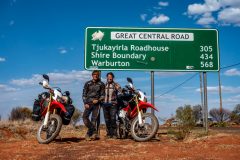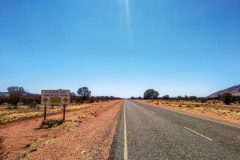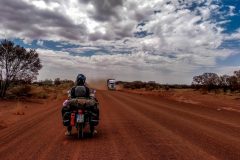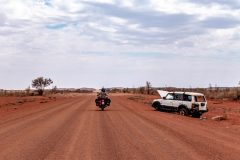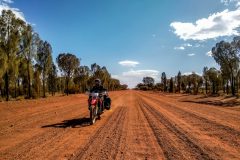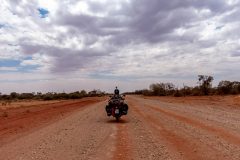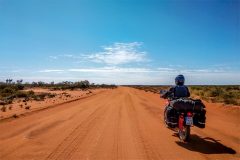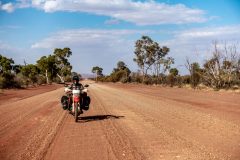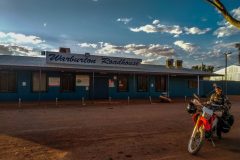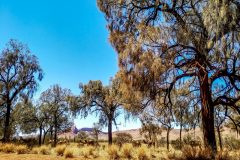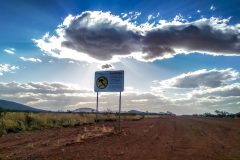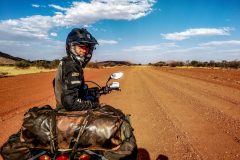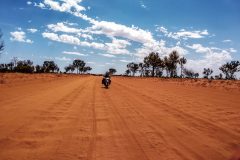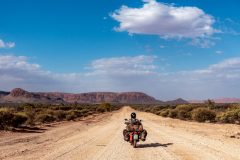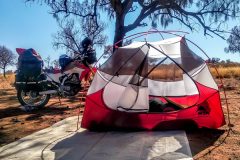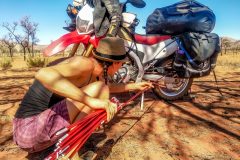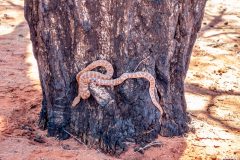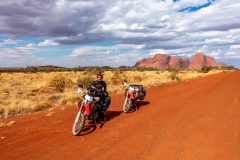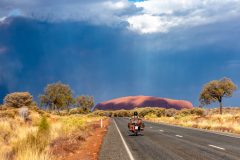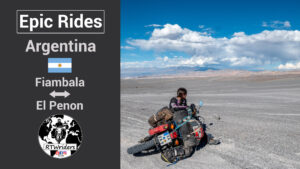Length: ~1100km (~700mi)
Duration: 3 to 4 days. We needed 4 days, but we also didn’t ride very fast and stopped often to take photos.
Start: The road starts in Laverton and leads through some aboriginal communities to Yulara. Cosmo Newbery – 85km (53mi), Tjukayirla Roadhouse – 300km (190mi), Warburton – 560km (350mi), Warakurna Roadhouse – 786km (488mi) Docker River – 890km (550mi) and Yulara – 1,109km (700mi).
Difficulty: The road is a graded dirt road in most parts, but seperated with deep sand parts inbetween. So you should not drive to fast, to not crash when the surface changes suddenly.
Special preparations: Always remember, that you are riding through a remote desert. It can be extremely hot during the days and very cold at night. Due to the temperatures, it is not recommendable to plan your trip in high summer.
Before you start your journey, you need to apply for two permits because you will be driving through Aboriginal area. You can register online here. It is for free and we got the permits one day later.
Gasoline, drinking water and basic food is available at the roadhouses. The distance between them is max 260km (160mi). Telephone reception is very rare and certainly not between the roadhouses.
They close at 5 pm and after that you have to pay AU$ 20 per vehicle, if you still want to fill up. Therefore it is advisable to plan your trip around these opening hours. Important! For any reason Warakurna roadhouse is operating with Northern Territory time. So coming from the Western Australian side means, it closes already at 3.30 pm!
It is very important to carry enough food and enough water for some days, in case you have a breakdown or accident. There is hardly any water available you could filter in an emergency case.
Riding west to east, you still have vehicles coming by consistently in the beginning. The more you come to the Northern Territory side the less traffic you will find. After Warakurna we saw no people anymore for a long time. There are thousands of bush flies everywhere during the day time. So you are hardly able to enjoy camping before sunset. Best is to bring a fly net for your head.
How was it?
After we have left tarmac at Laverton, we can see the huge road sign, that marks the beginning of the Great Central Road. To be honest – we are a bit excited, because we have been told so many horror stories and people have advised against riding it.
It is already afternoon. Therefore we only drive on for around 50km and pitch our tent off the road to be a little bit hidden afterwards.
The next morning we ride all the way to Tjukayirla road house and look for a tent site a few kilometers later. There are still mines nearby in this first part of the Great Central Road. Hence the route is regularly used by large trucks and the condition is much better than we have expected.
Noticable are the many car wrecks everywhere on the roadside. The Great Central Road is probably the longest car graveyard in the world. Especially in the vicinity of Aboriginal communities, burned-out vehicles are all over the road or sideways in the desert. Not only does it look strange, it also conveys the feeling that quite some vehicles couldn’t make it to the other side…
On the way to Warburton the next day, the road gets a little worse and is more and more potholed. This part feels already very remote and we hardly see a single human soul the whole time. Surprisingly there are even a few shorter sections with tarmac.
Warburton is an Aboriginal community in the middle of nowhere. There is an absolute ban on alcohol and you are not allowed to bring normal petrol to these regions. This also applies to many other Aboriginal areas. We have already heard of the trouble in Australia concerning Aboriginals and alcohol. However we didn’t know that the natives sniff gasoline instead, because it was much cheaper than alcohol. Thus Gasoline must be denatured in such places. At the petrol stations this “un-sniffable” gasoline is called OPAL.
We only reach the gas station in Warburton 20 minutes before closure time. But – what the heck is going on here? The campsite next to the roadhouse is secured with a huge barbed wire fence. The petrol pumps are enclosed in metal boxes and noisy cars and motorbikes are parked in front of the entrance. Aboriginal people are bustling with excitement everywhere, apparently to go shopping shortly before the shop closes. Sometimes they only wear some fabric tied around their bodies and are painted all over their bodies. Did we end up in a Mad Max film location?
Miriam struggles through the shop door while I watch the bikes outside. Inside is a complete mayhem and bodyguards try to control the situation as far as possible. Miriam has trouble to inform the cashiers that we want to fill up. Luckily we manage to buy petrol before the road house is closed. Five minutes later the raging crowd has completely disappeared and the whole forecourt is swept empty – as if nothing has ever happened here before. We have no clue if this was a special event that day. Maybe that’s the normal state here?
People have advised us to stay in the safe campsites at the road houses. However we don’t see a reason why we can’t simply camp anywhere in the outback.
Shortly after Warburton we suddenly notice hundreds of camels everywhere. Before we came to Australia, we have never heard that they have camels at all. They were introduced a long time ago to transport goods around the country. After trucks and cars were invented, they were simply released into the desert without thinking of the consequences. They seem to thrive here magnificently, but are a real nuisance for australian farmers.
We can also hear them in the night and hope that they won’t get tangled up in our tent, or trample us down.
The landscape is getting more and more beautiful the closer we come to the Northern Territory border. Luckily the Warakurna road house is only about 200km away from our campsite. This is a good thing, because for some reason this community lives after the Northern Territory time, which means that they are 1,5 hours ahead. So the petrol station already closes at 3:30pm and you can pay AU$ 20 per vehicle afterwards or wait until the next morning.
A few kilometers before Warakurna the road gets really bad. Deep sand and unpleasant bumps change every hundred meters. We have to ride much slower than before.
At the gas station we take a rest in the shade for half an hour. A police car stops and the officers start talking to us. They are very nice, but tell us to be extremely cautious on the upcoming section of the route. Two bikers recently died, because they were riding too fast and fell. Until they were finally found, it already was too late. This is the most remote part of the Great Central Road.
Eventually the road condition is not really worse than it was before. Regardless you have to ride through soft sand over and over, that makes it not advisable to go fast. The landscape becomes more mountainous. We have left the flat part of the route and is very scenic now. The state border only consists of a road sign, indicating that we are leaving Western Australia. No border buildings, no food controls – this is really the middle of nowhere.
Clouds are gathering and it seems like we’ll have a thunderstorm. We find a nice campground at Docker River and luckily the rain is passing by.
The next morning Tobi packs his sleeping bag while kneeling in front of the tent entrance. He frantically jumps back a few meters after he has noticed an uninvited guest below the ground sheet. A snake is sitting there and has probably warmed up at night.
We don’t know this type of snake, but with the large number of fatally poisonous snakes in Australia, we have to be extremely careful. After we have managed to scare it off the tent, the stupid animal creeps to Tobi’s motorcycle to make itself comfortable between the chain and the rear swing arm. Starting the engine doesn’t scare it off either. Maybe it even enjoys the vibrations? We need more than half an hour to get it off the bike by using a tent pole. What an excitement in the early morning. We later found out that it was just a Stimson Python. Nevertheless, we decided to be more careful in future and have a closer look below the tent in the morning.
After breakfast we only have 150km left to the end of the Great Central Road, but this part is very sandy and strenuous. Shortly before Mount Olga we reach asphalt again. Our tour of the Great Central Road is finished and it really was fantastic. We almost skipped it, because so many locals advised us against it. We actually expected a boring route through the outback. Especially the last part was very scenic though.
A few kilometers later we see Mount Olga, a huge sandstone rock that is hardly less spectacular compared to the famous Ayers Rock. It is still early afternoon and we decide to drive on to Ayers Rock. The sky looks a bit thundery, but generates a cool looking and unreal atmosphere. If you arrive to the national park coming from the west, there is no toll station for the park entrance. Therefore we ride to Ayers Rock directly and face an absolutely breathtaking view.
A cloudy sky is not very common in this area. Most of the Ayers Rock photos show a blue sky. Right next to the massive cliff is a bush fire. Black smoke has filled the sky and only a small hole is left, where sun beams can pass to hit the giant sandstone rock. What a sight!
At Sunset Point we get flabbergasted. After a few days with almost no people, hundreds of people are romping around with their cameras and waiting for the sunset. Suddenly everything is fenced and you can’t just walk around freely. Climbing Ayers Rock was also prohibited about two weeks before. We decide to circle the crag once and continue our journey afterwards. It is just too crowded at this place.
After we have left the national park, we try to find a campground close to Uluru. This town is very upscale and wild camping is prohibited everywhere, of course. We need some effort, but can finally find a very good place in the wilderness.
Conclusion: We are still happy, that we decided to ride this fantastic road. Although it is a straight route most of the time, it is not boring at all. The camping is fantastic and it is a cool experience in the australian outback. Unfortunately they want to tar the whole road in the future. So you probably have to hurry up, before this adventurous ride will become a boring desert highway for everybody.


